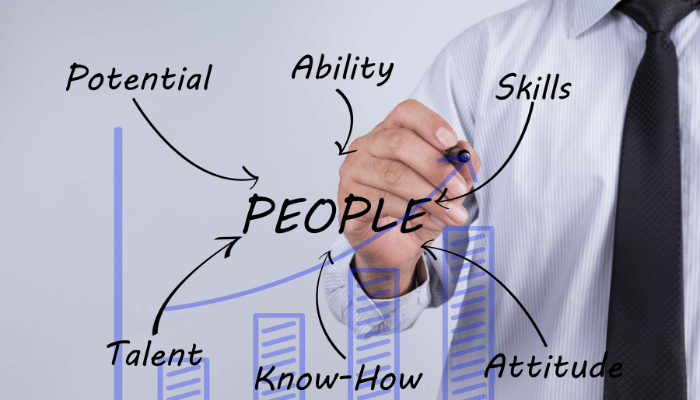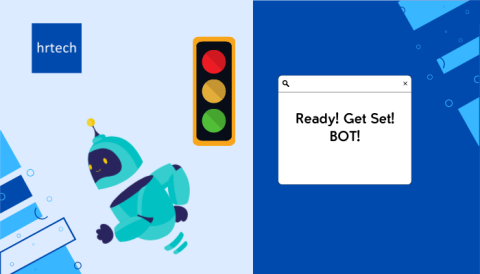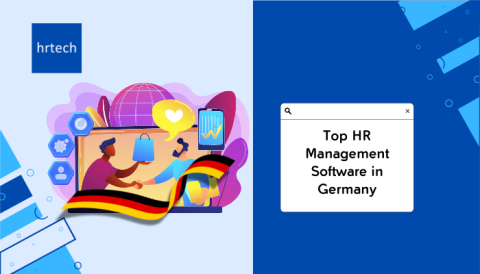Ever feel like managing HR is like trying to solve a Rubik’s cube while riding a unicycle? Yeah, it’s a head-scratcher. Spending hours chasing down approvals, drowning in manual tasks, and wishing there were more hours in the day? Yeah! Traditional HR processes can be a productivity black hole. Are you really working smart when you’re buried under paperwork and spreadsheets? Is there a better way to manage your workforce and become a strategic HR powerhouse instead of a glorified data entry clerk?
Spoiler alert: There absolutely is!
Enter the HRMS system, your ticket to HR nirvana (or at least a much more efficient workday). Let’s explore how an HRMS can transform your department from analog to awesome! Now that we’ve established the urgent need for an HR hero (ahem, that’s you!), let’s delve into the world of HRMS systems. In simpler terms, an HRMS (Human Resource Management System) is your digital sidekick, a one-stop shop for streamlining all your HR functions.
It can handle everything from employee onboarding and payroll to performance management and benefits administration. But how exactly does this system work its magic? Let’s break it down into manageable chunks:
Introduction to Human Resources Management System (HRMS):

Here’s a quick breakdown to get you started:
- HRMS (Human Resource Management System): This is your main umbrella term, encompassing all the software applications that streamline your HR processes.
- HRIS (Human Resource Information System): Think of this as the OG of hrtech. HRIS systems primarily focus on storing and managing employee data electronically. While HRIS is a core component of an HRMS, the latter offers a wider range of functionalities.
- HCM (Human Capital Management): This term broadens the scope beyond technology, encompassing the entire strategic approach to managing your workforce. An HRMS can be a powerful tool that supports your overall HCM strategy.
Imagine this: Endless stacks of paperwork, chasing down approvals via email, and manually calculating payroll. Sounds like an HR nightmare, right? An HRMS system swoops in like a superhero and replaces that chaos with streamlined efficiency. Here’s how:
- Automation: Repetitive tasks like data entry and sending out forms become a thing of the past. The HRMS automates these processes, freeing up your valuable time for more strategic HR initiatives.
- Centralized Data Management: Say goodbye to scattered spreadsheets and sticky notes! An HRMS provides a single source of truth for all your employee data, making it easier to access, update, and analyze.
- Improved Workflow Management: HRMS systems establish clear workflows for tasks like onboarding, performance reviews, and leave requests. This ensures consistency and eliminates the confusion of “who needs to approve this?”
- Enhanced Reporting and Analytics: With all your HR data in one place, you can generate insightful reports that track trends, identify areas for improvement, and make data-driven decisions for your workforce.
The magic of HRMS lies in its ability to bridge the gap between the traditional world of HR and the power of technology. Here’s how it works:
- Software as a Service (SaaS): Most HRMS systems are cloud-based, meaning you access them through a web browser. This eliminates the need for expensive hardware installations and makes it easy for your team to access the system from anywhere, anytime.
- User-friendly Interface: Modern HRMS platforms are designed with user experience in mind. They offer intuitive interfaces that are easy to learn and navigate, even for non-technical users.
- Customization Options: Not all HR needs are created equal. Many HRMS systems allow you to customize workflows, reports, and access controls to fit your specific organizational requirements.
Evolution And History Of HRMS:
In the bygone days of the 1970s, HR departments relied heavily on manual processes, paper files, and a whole lot of patience. The introduction of early HR software marked a turning point. These systems offered basic functionalities like payroll processing and employee record management, laying the foundation for future advancements.
As technology progressed, Enterprise Resource Planning (ERP) systems emerged in the 1980s and 1990s. While not exclusively focused on HR, ERP systems offered integrated modules for HR functions alongside other business operations like finance and accounting. This marked a shift towards a more holistic approach to data management.
The late 1990s and early 2000s saw the rise of dedicated HR software solutions like SAP R/2 and PeopleSoft. These comprehensive HRMS platforms offered a wider range of functionalities, including:
These advancements allowed HR professionals to manage the entire employee lifecycle within a single system, leading to significant improvements in efficiency and data accuracy.
Emergence of Cloud-Hosted HR Services and Mobile Applications
Fast forward to the present day, and the HRech landscape has undergone a major transformation. Cloud-based HRMS solutions have become the norm, offering several advantages:
- Scalability: Cloud-based systems can easily adapt to accommodate growing organizations without the need for expensive hardware upgrades.
- Accessibility: HR professionals and employees can access the system from anywhere with an internet connection, promoting remote work flexibility.
- Cost-effectiveness: Cloud-based solutions typically operate on a subscription model, eliminating the upfront costs associated with traditional software licenses.
Mobile applications have also become an integral part of the HRMS experience. These apps allow employees to access paystubs, request leave, and update personal information on the go, further streamlining HR processes and empowering employees with self-service capabilities.
The future of HRMS is brimming with exciting possibilities. Modern systems are increasingly incorporating cutting-edge technologies like:
- Predictive Analytics: By analyzing historical data and trends, HRMS systems can predict future outcomes, such as employee turnover or skills gaps. This allows HR professionals to make data-driven decisions and implement proactive strategies.
- Artificial Intelligence (AI): AI-powered chatbots can answer employee questions 24/7, reducing the burden on HR teams and providing a personalized employee experience. AI can also be used for tasks like resume screening and candidate evaluation, freeing up HR professionals for more strategic work.
These advancements are transforming HRMS from a mere data management tool into a powerful strategic partner, enabling HR departments to become more proactive, data-driven, and future-proof.
Core Functions and Components of HRMS- Your All-in-One HR Toolkit:

An effective HRMS system supports your entire workforce journey, from attracting top talent to gracefully managing employee departures. Here’s a breakdown of some key functionalities:
- Recruitment: Manage job postings, automate applicant screening, and schedule interviews – all within the HRMS platform.
- Onboarding: Streamline the new hire experience with digital onboarding forms, document management, and role-based training modules.
- Performance Management: Set clear goals, conduct performance reviews, and track employee progress using the HRMS system. This fosters continuous feedback and development opportunities.
- Learning and Development: Provide employees with access to training materials, online courses, and development programs directly through the HRMS, promoting continuous learning and skill development.
- Compensation and Benefits: Manage payroll processing, track benefits enrollment, and ensure compliance with tax regulations through the HRMS platform.
- Separation Management: Simplify the exit process with automated workflows for tasks like offboarding paperwork and final pay calculations.
By managing the entire employee lifecycle within a single system, HR teams can ensure consistency, improve data accuracy, and gain valuable insights into their workforce.
Key Components
Let’s take a deeper dive into some of the essential components that make up a comprehensive HRMS:
- Payroll Management: Process salaries and deductions accurately and efficiently with built-in payroll features. Many HRMS systems also integrate with tax and accounting software for seamless financial management.
- Benefits Tracking: Manage employee benefits enrollment, track plan details and contributions, and ensure compliance with complex regulations. This simplifies administration and reduces the risk of errors.
- Performance Management: Set goals, track progress, conduct performance reviews, and provide feedback – all within the HRMS platform. This fosters a culture of continuous improvement and development for employees.
Many HRMS systems are modular, allowing you to choose the functionalities that best suit your organization’s needs. Here are some common HRMS modules:
- Payroll: Streamline payroll processing with automated calculations, deductions, and tax filings.
- Time and Attendance: Track employee work hours, overtime, and vacation time electronically. This promotes accountability and simplifies timekeeping.
- Benefits Administration: Manage employee benefits enrollment, track plan details and contributions, and ensure compliance with complex regulations.
- Recruitment: Advertise job openings, screen applicants, schedule interviews, and manage the entire hiring process through the HRMS.
- Learning Management System (LMS): Deliver training materials, online courses, and development programs directly through the HRMS platform.
- Performance Management: Set goals, conduct reviews, provide feedback, and track employee progress within a centralized system.
By selecting the appropriate modules, you can build a customized HRMS solution that perfectly aligns with your specific requirements.
Modern HRMS systems empower employees with self-service functionalities through employee self-service (ESS) portals. These portals allow employees to:
- Access pay stubs and tax documents
- Request leave and track vacation time
- Update personal information
- Enroll in benefits plans
- View training materials and development opportunities
ESS features not only improve employee convenience and satisfaction but also free up HR professional’s time to focus on more strategic tasks.
Modern HRMS systems empower employees by providing transparency and boosting communication. You can further transform your organization with stunning visuals (for example, magicinnovations.com) that captivate employees and motivate them to engage more actively in their roles.
We’ll next explore the key features that define an effective HRMS and how they can empower your HR team to achieve greater efficiency and success.
Features of an Effective HRMS:
Effective HRMS systems go beyond basic data storage and offer a comprehensive suite of features to manage all aspects of your workforce. Here are some common functionalities you can expect:
- Applicant Tracking System (ATS): Streamline the recruitment process by attracting top talent, screening resumes, and managing the hiring pipeline efficiently.
- Performance Management Tools: Set clear goals and expectations, conduct performance reviews, and track employee progress for a data-driven approach to development.
- Learning Management System (LMS): Empower employees with access to training materials, online courses, and development programs directly within the HRMS platform.
- Benefits Administration: Simplify benefits enrollment, track plan details and contributions, and ensure compliance with regulations.
- Reporting and Analytics: Generate insightful reports that track HR metrics, identify trends, and support data-driven HR decisions.
And yeah, the specific features offered by an HRMS will vary depending on the vendor and the chosen modules.
Manual processes are a thing of the past with an HRMS. Here’s how automation enhances your HR operations:
- Automated Workflows: Streamline repetitive tasks like approvals, onboarding processes, and leave requests, freeing up HR professionals’ time for more strategic work.
- Automated Data Entry: Reduce errors and save time by automating data entry tasks, ensuring your HR data remains accurate and up-to-date.
- Automated Reminders and Notifications: Stay on top of deadlines with automated reminders for tasks like performance reviews, training deadlines, and benefit enrollment.
With automation taking care of the mundane, HR teams can focus on more strategic initiatives, fostering a more efficient and productive work environment. But security is paramount. Effective HRMS systems also offer robust security features to safeguard sensitive employee data, including:
- Access Controls: Define user permissions and restrict access to sensitive data based on job roles and responsibilities.
- Data Encryption: Ensure employee data is protected with industry-standard encryption protocols.
- Audit Trails: Maintain a record of user activity to track data access and modifications for enhanced security.
Staying compliant with complex labor laws and regulations can be a constant challenge for HR professionals. But an HRMS can be your secret weapon:
- Compliance Management Tools: Track regulatory updates, manage compliance training for your workforce, and ensure adherence to labor laws.
- Automated Reporting: Generate reports that demonstrate compliance with regulations, simplifying audits and reducing the risk of penalties.
Additionally, HRMS systems can provide valuable data and analytics to help you:
- Identify trends: Analyze HR data to identify potential areas of non-compliance and take proactive measures to address them.
Benchmark performance: Compare your HR metrics against industry standards to identify areas for improvement and ensure your compliance practices are effective.
Benefits of Implementing an HRMS
| Benefits | Description | Impact on HR Department | Impact on Organization |
| Enhanced HR Roles & Efficiency | Automation streamlines tasks, frees HR for strategic work, data-driven decision making | More efficient workflows, reduced workload, focus on strategic initiatives | Increased productivity, improved decision making |
| Improved Workforce Planning & Retention | Data-driven workforce planning, talent management, employee engagement initiatives | Strong and engaged workforce, reduced turnover | Strong talent pipeline, competitive advantage |
| Better Recruitment & Compliance | Streamlined recruitment process, reduced errors in compliance, improved employer branding | Efficient talent acquisition, reduced compliance risks | Attracts top talent, builds strong employer reputation |
| Employee Self-Service & Productivity | Increased employee convenience, reduced burden on HR, improved transparency & communication | More efficient work environment, empowered employees | Increased employee satisfaction, improved productivity |
Security Considerations in HRMS
Here are three key things to remember when securing your HRMS:
1. Lock it Tight: Data Encryption & Access Controls
Think of your HRMS as a virtual bank. Just like a bank, it needs top-notch security features. Look for an HRMS system that encrypts your data using a complex code, like a super-secret password. Additionally, ensure the system allows you to control access based on job roles. Imagine giving everyone a key to the bank – not ideal! With access controls, only authorized personnel can access specific information, keeping everything safe and sound.
2. Be Prepared: Backups & Disaster Recovery
Life throws curveballs, and your HRMS is no exception. Even the most secure systems can face unexpected challenges. That’s why having backups is crucial, like having a safety deposit box for your valuables. These backups ensure you can recover your data quickly if needed. Additionally, ask your HRMS provider about their disaster recovery plan. Think of it as a fire escape for your data – a clear plan to get things back up and running if something goes wrong.
3. Teamwork Makes the Dream Work: Employee Training & Awareness
Security isn’t a one-person job! Here’s where your employees come in. Educate them on cybersecurity best practices, like creating strong passwords (think of it as a complex combination for their own personal data vault within the HRMS). Regularly review user access privileges – like making sure everyone still has the correct keys!
Finally, establish clear procedures for reporting suspicious activity. If someone sees something strange at the bank, they tell security, right? The same goes for your HRMS. By working together, you can create a strong security culture within your organization.
Selection and Implementation of an HRMS
Choosing the right HRMS is like finding the perfect pair of shoes – it needs to fit your organization’s specific needs. Here are some key considerations:
- Identify Your HR Challenges: What are your biggest pain points? Is it streamlining recruitment, improving performance management, or simplifying payroll? Understanding your needs will guide your selection process.
- Define Your Budget: HRMS systems come in a variety of price ranges based on features and functionalities. Determine your budget upfront to narrow down your options.
- Consider Customization Options: Does the HRMS offer customization capabilities to adapt to your specific workflows and reporting needs? Flexibility is key for a smooth implementation.
- Security Features are Non-Negotiable: As we discussed, robust security features are essential to protect your sensitive employee data. Don’t settle for anything less!
- Read Reviews and Ask for Demos: Researching user reviews and requesting product demonstrations can provide valuable insights into the user experience and functionality of different HRMS options.
Once you’ve chosen your HRMS champion, it’s time for implementation. Here are some steps to ensure a successful transition:
- Data Migration: Plan how you will migrate your existing HR data into the new system. This may involve data cleansing and ensuring compatibility.
- User Training: Provide comprehensive training to your HR team and employees on how to navigate and utilize the new HRMS platform.
- Change Management Strategy: Implementing a new system can bring change anxieties. Develop a communication plan to keep employees informed and address any concerns throughout the process.
- Go Live and Monitor: After a successful launch, monitor system usage and gather feedback from HR and employees. This allows for ongoing adjustments and ensures the HRMS meets your organization’s needs.
Checklist for Selecting the Right HRMS:
- Identify HR needs and challenges.
- Set a budget for the HRMS system.
- Research and shortlist potential HRMS vendors.
- Evaluate features and functionalities of shortlisted options.
- Request demos and compare user experience.
- Prioritize security features and data compliance.
- Read customer reviews and references.
- Select the HRMS that best suits your requirements.
In today’s dynamic business landscape, HR departments are under increasing pressure to attract top talent, manage a diverse workforce effectively, and ensure compliance with complex regulations. Cloud-based HRMS solutions are no longer a luxury, but a strategic necessity for HR departments seeking to modernize their operations and achieve greater efficiency.
Here’s why prioritizing cloud-based HRMS selection is vital for your organization:
- Enhanced Scalability and Flexibility: Cloud-based HRMS systems are inherently scalable, adapting to your organization’s growth without the need for expensive hardware upgrades. This flexibility allows you to add new features and functionalities as your needs evolve.
- Improved Accessibility and Remote Work Support: Cloud technology allows HR professionals and employees to access the HRMS platform from anywhere, anytime, with an internet connection. This fosters remote work capabilities and empowers employees with self-service functionalities, streamlining HR processes and boosting convenience.
- Reduced IT Burden and Cost Savings: Cloud-based HRMS eliminates the need for in-house IT infrastructure and maintenance. The vendor takes care of system upkeep and security updates, freeing up your IT resources and reducing overall costs.
- Real-Time Data Insights and Strategic Decision Making: Cloud-based HRMS systems provide real-time access to HR data, enabling you to generate insightful reports and make data-driven decisions. This empowers HR professionals to identify trends, address potential issues proactively, and develop strategic workforce management plans.
- Enhanced Security and Compliance: Cloud-based HRMS vendors invest heavily in robust security measures to safeguard sensitive employee data. Regular data backups and disaster recovery plans ensure business continuity and minimize the risk of data breaches. Additionally, cloud-based systems can be automatically updated to comply with the latest regulations, reducing the burden on your HR team.
Many organizations struggle with a hodgepodge of disconnected HR systems – payroll software here, applicant tracking there, and performance management somewhere else. This data fragmentation creates a nightmare for HR professionals, hindering efficiency and insights. Here’s how to overcome these challenges and embrace a more integrated future:
- Identify Your System Pain Points: Start by assessing your current HR landscape. Where are the data silos? What manual workarounds are necessary to integrate information? Understanding these pain points will guide your transition strategy.
- Embrace Cloud-Based HRMS Solutions: Cloud technology offers a centralized platform for all your HR data, eliminating the need for multiple disconnected systems. This allows for seamless data flow, real-time reporting, and improved accessibility for your HR team.
- Data Migration with a Plan: Transitioning your HR data to a new system requires careful planning. Work with your chosen HRMS vendor to develop a data migration strategy that ensures accuracy and minimizes disruption.
- Change Management for a Smooth Transition: Implementing a new HRMS can bring about change anxieties. Develop a clear communication plan to keep employees informed and address any concerns throughout the process. Training on the new system is also crucial for user adoption and success.
Future of HRMS:
Before diving into comparisons, take a step back and identify your HR department’s biggest challenges. Are you struggling with a mountain of paperwork? Is attracting top talent a constant hurdle? Perhaps streamlining recruitment or improving performance management is your priority. Understanding your specific needs will guide your HRMS selection process and ensure you prioritize features that solve your most pressing problems.
Now, let’s explore some popular HRMS platforms and how they stack up:
- HR Marketplace: hrtech, a Singapore-based platform, takes a unique approach. It acts as an HR marketplace where you can browse listings from various HRMS vendors, compare features, and connect with potential solution providers. This can be a valuable resource for organizations seeking a wider selection and a guided vendor selection process.
- User-friendliness: For small and medium businesses seeking an intuitive interface, BambooHR shines.
- Affordability: Zoho People offers a budget-friendly option with robust applicant tracking and payroll functionalities.
- Enterprise-Level Solutions: Workday HCM caters to large organizations with its comprehensive features and powerful analytics.
- Data Security Focus: Cloud-based Rippling prioritizes data security and automation, perfect for organizations seeking a secure and streamlined HR experience.
| Platform | Core Strengths | Pricing |
| Hrtech | HR marketplace featuring various HRMS solutions, facilitates comparison and vendor selection | Freely browse platform listings, individual HRMS pricing varies |
| BambooHR | User-friendly interface, ideal for small and medium businesses | Varies based on company size and features |
| Zoho People | Affordable option with strong applicant tracking and payroll features | Subscription tiers with various pricing options |
| Workday Human Capital Management (HCM) | Comprehensive solution for large enterprises, strong analytics and reporting | Custom quotes based on organization size and needs |
| Rippling | Cloud-based platform with a focus on data security and automation | Subscription tiers with transparent pricing |
Conclusion:
Don’t let HR overwhelm you – unlock its potential!
By implementing a robust HRMS, you’ll streamline processes, gain data-driven insights, empower your HR team, and foster a thriving workforce. Take action today! Identify your HR challenges, explore solutions, request demos, and invest in the HRMS that propels your organization towards success.
The HR solution is right here – are you ready to embrace it?





